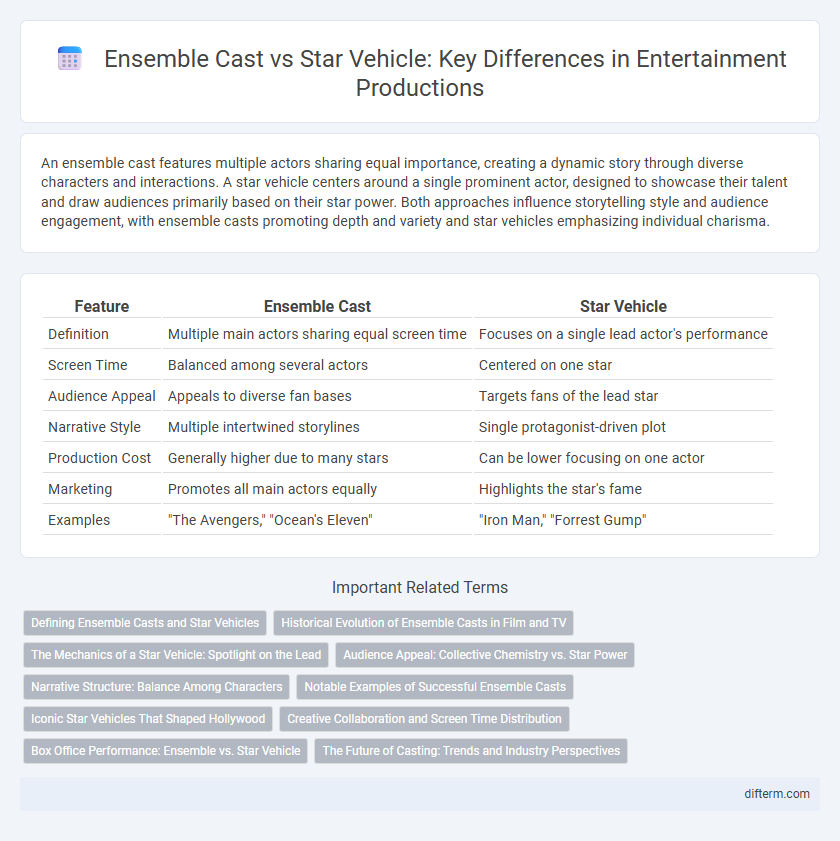An ensemble cast features multiple actors sharing equal importance, creating a dynamic story through diverse characters and interactions. A star vehicle centers around a single prominent actor, designed to showcase their talent and draw audiences primarily based on their star power. Both approaches influence storytelling style and audience engagement, with ensemble casts promoting depth and variety and star vehicles emphasizing individual charisma.
Table of Comparison
| Feature | Ensemble Cast | Star Vehicle |
|---|---|---|
| Definition | Multiple main actors sharing equal screen time | Focuses on a single lead actor's performance |
| Screen Time | Balanced among several actors | Centered on one star |
| Audience Appeal | Appeals to diverse fan bases | Targets fans of the lead star |
| Narrative Style | Multiple intertwined storylines | Single protagonist-driven plot |
| Production Cost | Generally higher due to many stars | Can be lower focusing on one actor |
| Marketing | Promotes all main actors equally | Highlights the star's fame |
| Examples | "The Avengers," "Ocean's Eleven" | "Iron Man," "Forrest Gump" |
Defining Ensemble Casts and Star Vehicles
Ensemble casts feature multiple principal actors who share relatively equal screen time and narrative importance, creating a balanced storytelling dynamic. Star vehicles center around a single leading actor, designed specifically to showcase their talents and persona, often driving the entire plot. This distinction impacts both the creative direction and marketing strategies of films and television shows within the entertainment industry.
Historical Evolution of Ensemble Casts in Film and TV
The historical evolution of ensemble casts in film and TV showcases a shift from star vehicles that focused on a single lead actor to more inclusive storytelling formats highlighting multiple key characters. Early Hollywood often prioritized marquee stars to attract audiences, but landmark productions like "The Seven Samurai" (1954) and TV series such as "The West Wing" redefined narrative dynamics by distributing focus across diverse, interwoven character arcs. This transition reflects broader industry trends emphasizing complex, multifaceted storytelling and audience engagement through rich ensemble interactions.
The Mechanics of a Star Vehicle: Spotlight on the Lead
A star vehicle centers narrative and marketing efforts around a high-profile lead actor, leveraging their charisma and established fan base to drive box office success. The mechanics of a star vehicle involve crafting storylines that highlight the lead's unique talents, often assigning them dominant screen time and pivotal plot roles. In contrast, an ensemble cast distributes focus evenly across multiple characters, creating a balanced dynamic that thrives on diverse performances rather than a single star's appeal.
Audience Appeal: Collective Chemistry vs. Star Power
Ensemble casts attract audiences by showcasing collective chemistry, where multiple characters contribute to dynamic storytelling and create a balanced, immersive experience. Star vehicles rely heavily on the appeal of a single, well-known actor whose charisma and fan base drive box office success and media attention. Both approaches offer distinct audience engagement strategies: ensemble casts emphasize relational depth, while star vehicles capitalize on individual star power.
Narrative Structure: Balance Among Characters
Ensemble casts distribute narrative focus evenly among multiple characters, creating interconnected storylines that enhance plot complexity and character development. Star vehicles center the narrative around a single protagonist, offering a focused character arc that drives the story momentum. Balancing character presence in ensemble works fosters diverse perspectives, while star-driven narratives emphasize individual transformation.
Notable Examples of Successful Ensemble Casts
Notable examples of successful ensemble casts include films like "The Avengers," which combines multiple superheroes to create dynamic storytelling appealing to diverse audiences. Television series such as "Game of Thrones" utilize large ensembles to develop intricate, interwoven character arcs that drive prolonged viewer engagement. The effectiveness of ensemble casts lies in their ability to balance multiple storylines and showcase varied talent, creating rich narratives that often outperform star vehicle-driven projects.
Iconic Star Vehicles That Shaped Hollywood
Iconic star vehicles like Marilyn Monroe's *Gentlemen Prefer Blondes* and Tom Cruise's *Top Gun* significantly shaped Hollywood by showcasing singular talent and driving box office success. These films prioritize a central star's charisma and persona, distinguishing them from ensemble casts that distribute narrative focus among multiple actors. Star vehicles often create lasting cultural impact by cementing an actor's legacy and defining cinematic eras.
Creative Collaboration and Screen Time Distribution
Ensemble casts foster creative collaboration by distributing screen time evenly among multiple actors, enabling diverse character interactions and balanced storytelling. Star vehicles center narrative focus on a single lead, often limiting screen time for supporting characters and concentrating creative input around the star. This distinction influences the storytelling dynamic, with ensembles promoting collective performance synergy while star vehicles highlight individual actor prominence.
Box Office Performance: Ensemble vs. Star Vehicle
Ensemble cast films often achieve strong box office performance by appealing to diverse audience segments through multiple recognizable actors, spreading marketing appeal across various fan bases. Star vehicle movies rely heavily on a single star's popularity, which can drive initial ticket sales but may limit long-term revenue if the story or supporting cast lacks depth. Data from box office analytics reveal that ensemble films generally sustain steadier revenue streams over time, while star vehicles exhibit sharper opening weekends followed by steeper declines.
The Future of Casting: Trends and Industry Perspectives
Ensemble casts promote diverse storytelling by showcasing multiple characters with equal importance, fostering collaborative performances that appeal to audiences craving complex narratives. Star vehicles continue to attract significant box office revenue by leveraging high-profile actors' established fan bases and marketability, ensuring commercial viability for major studio projects. Emerging trends indicate a balanced integration of ensemble and star-driven approaches, influenced by streaming platforms prioritizing varied content and audience engagement metrics.
ensemble cast vs star vehicle Infographic

 difterm.com
difterm.com